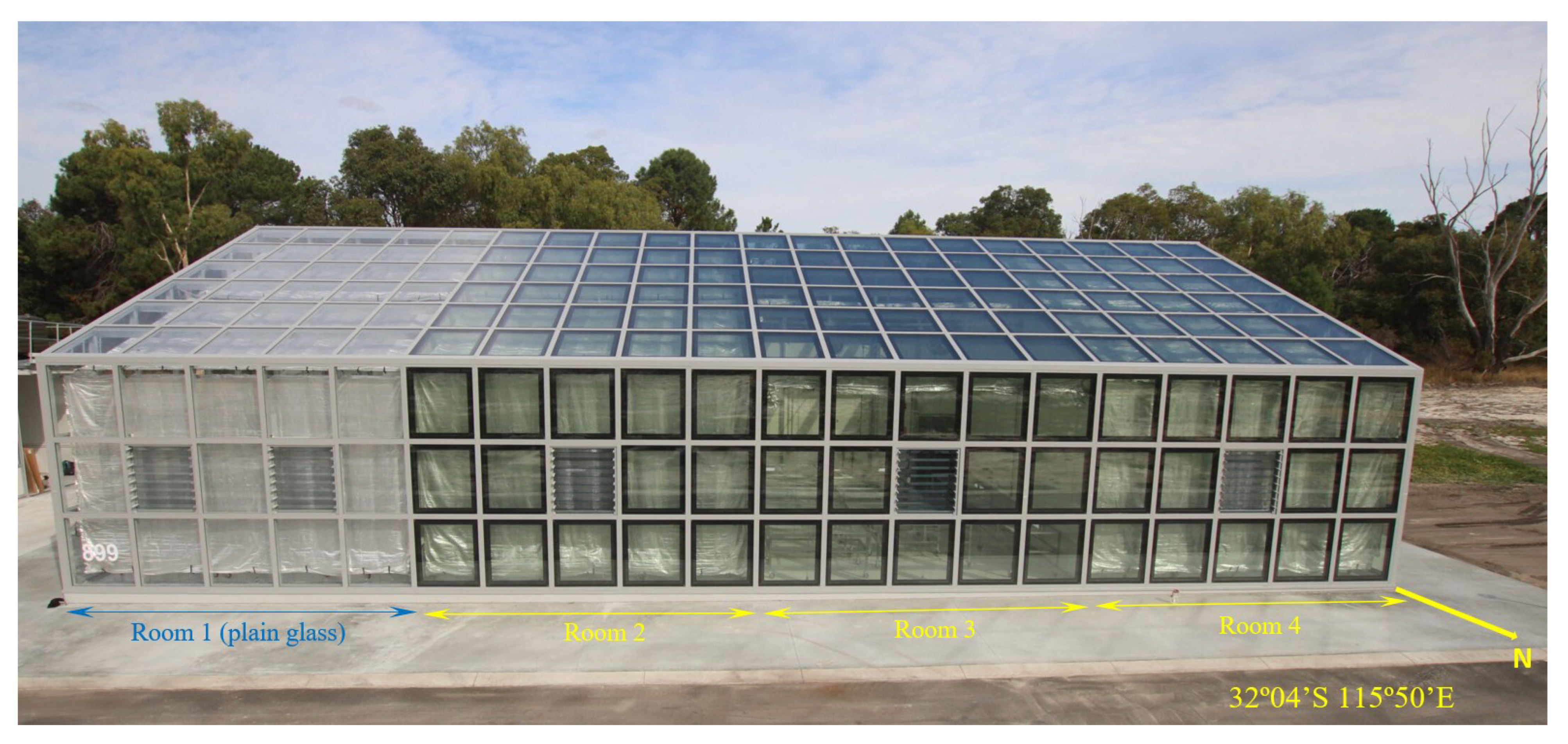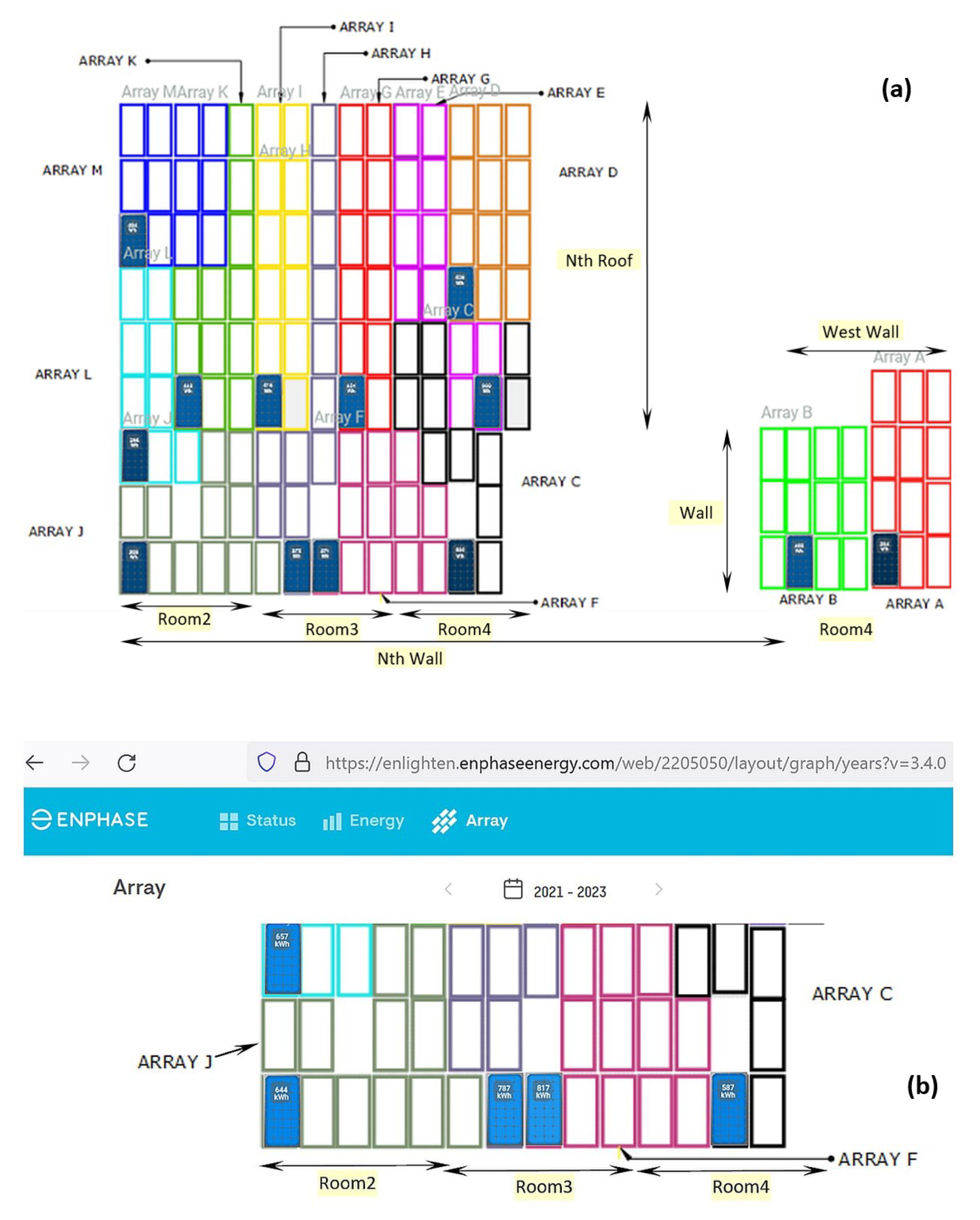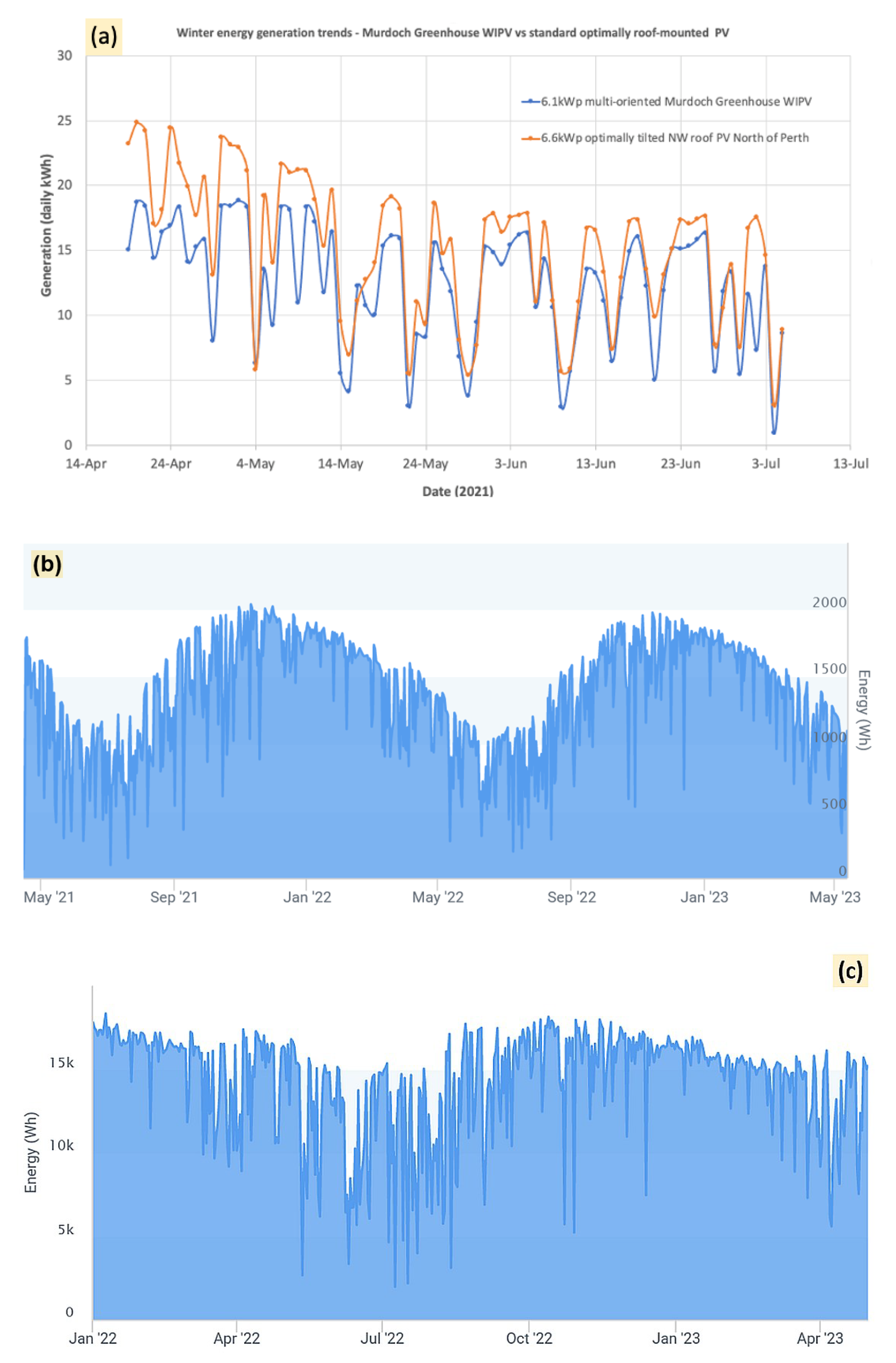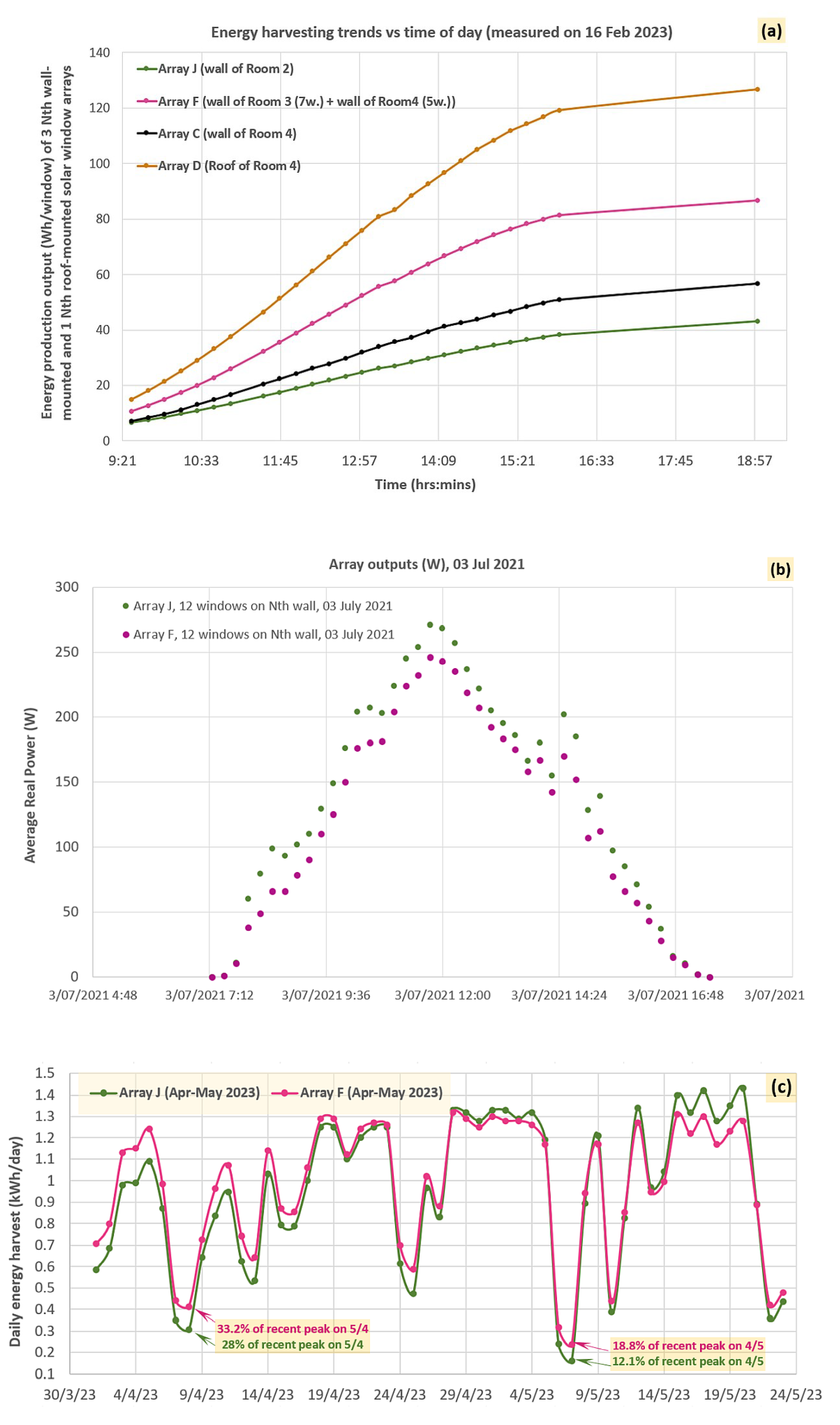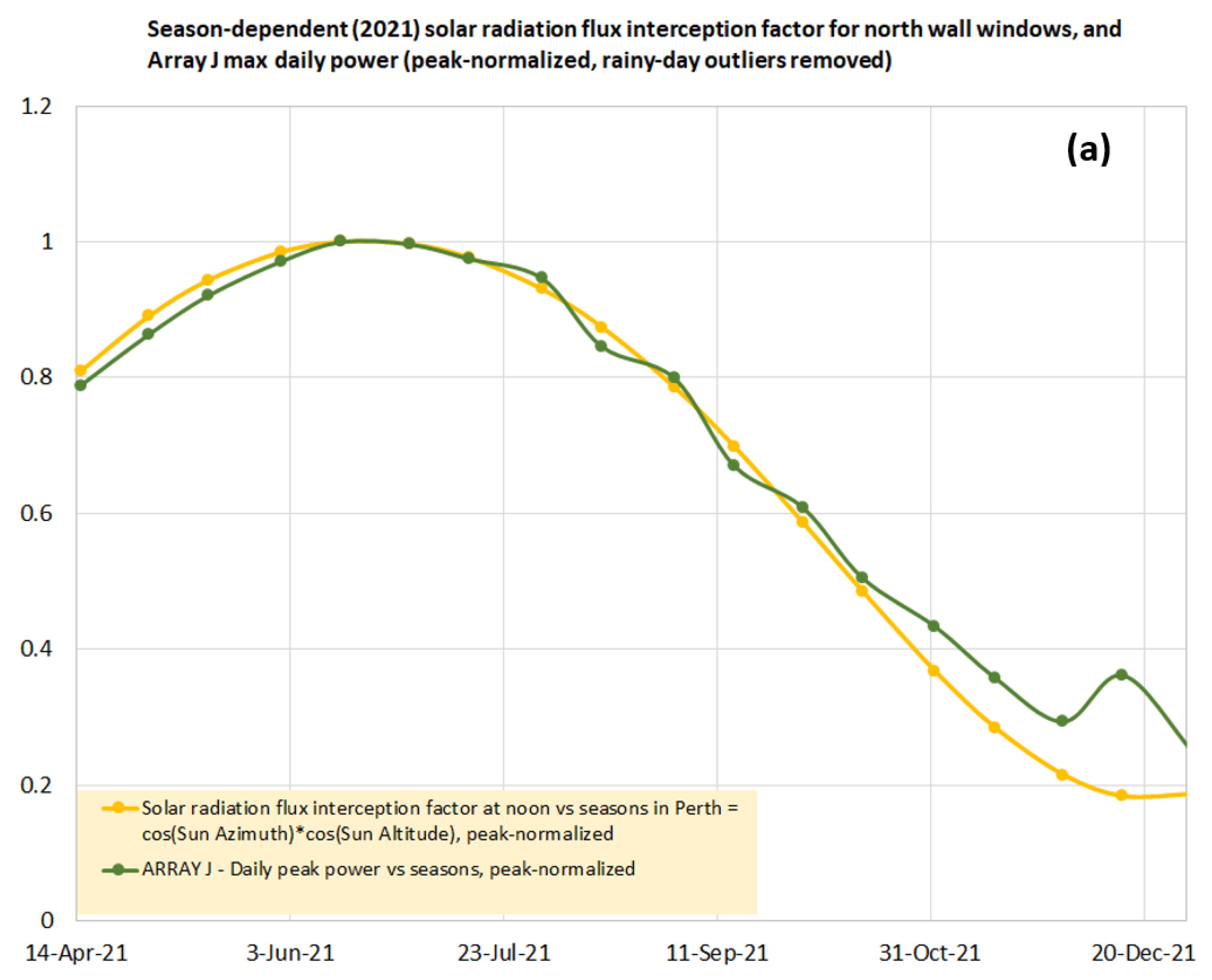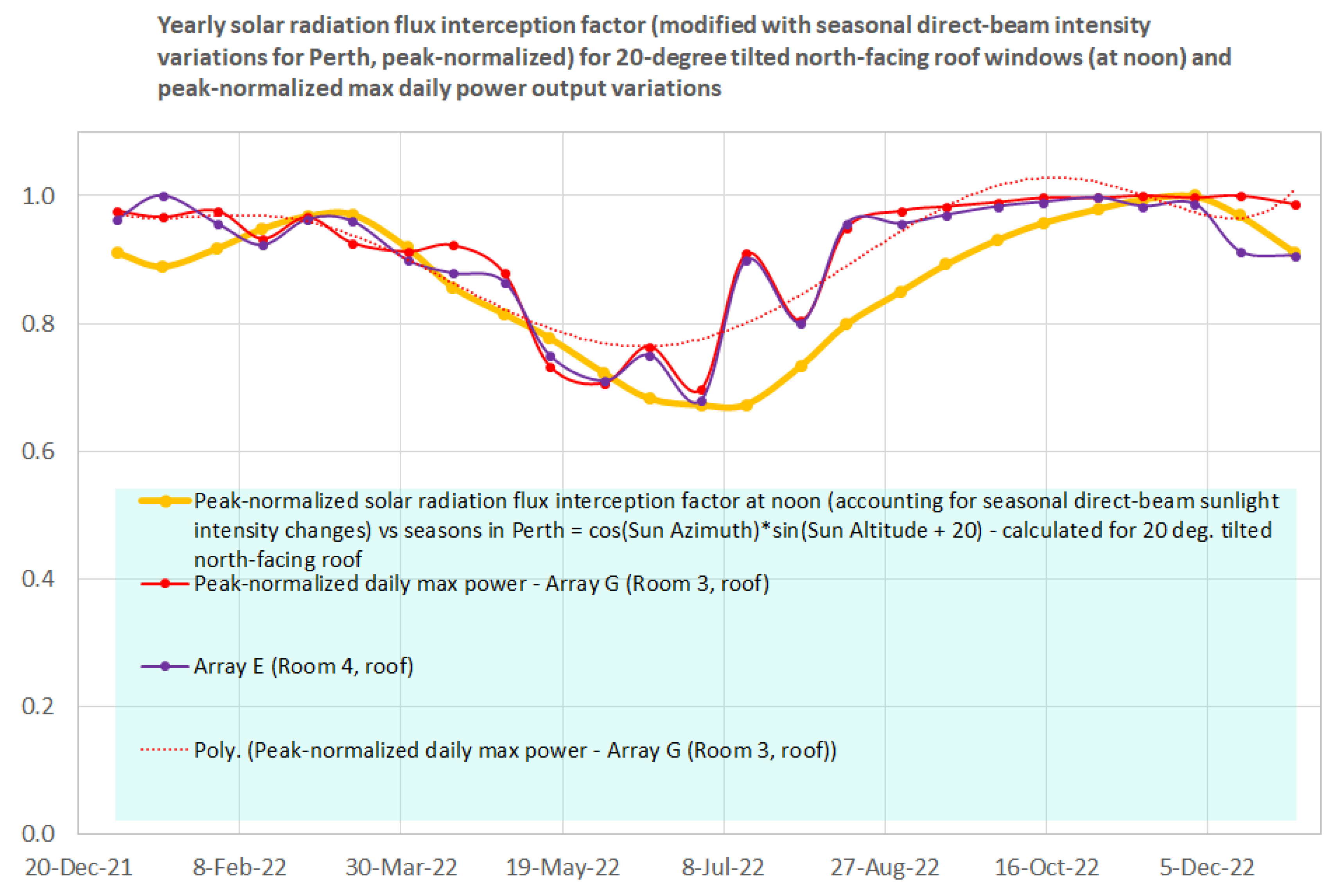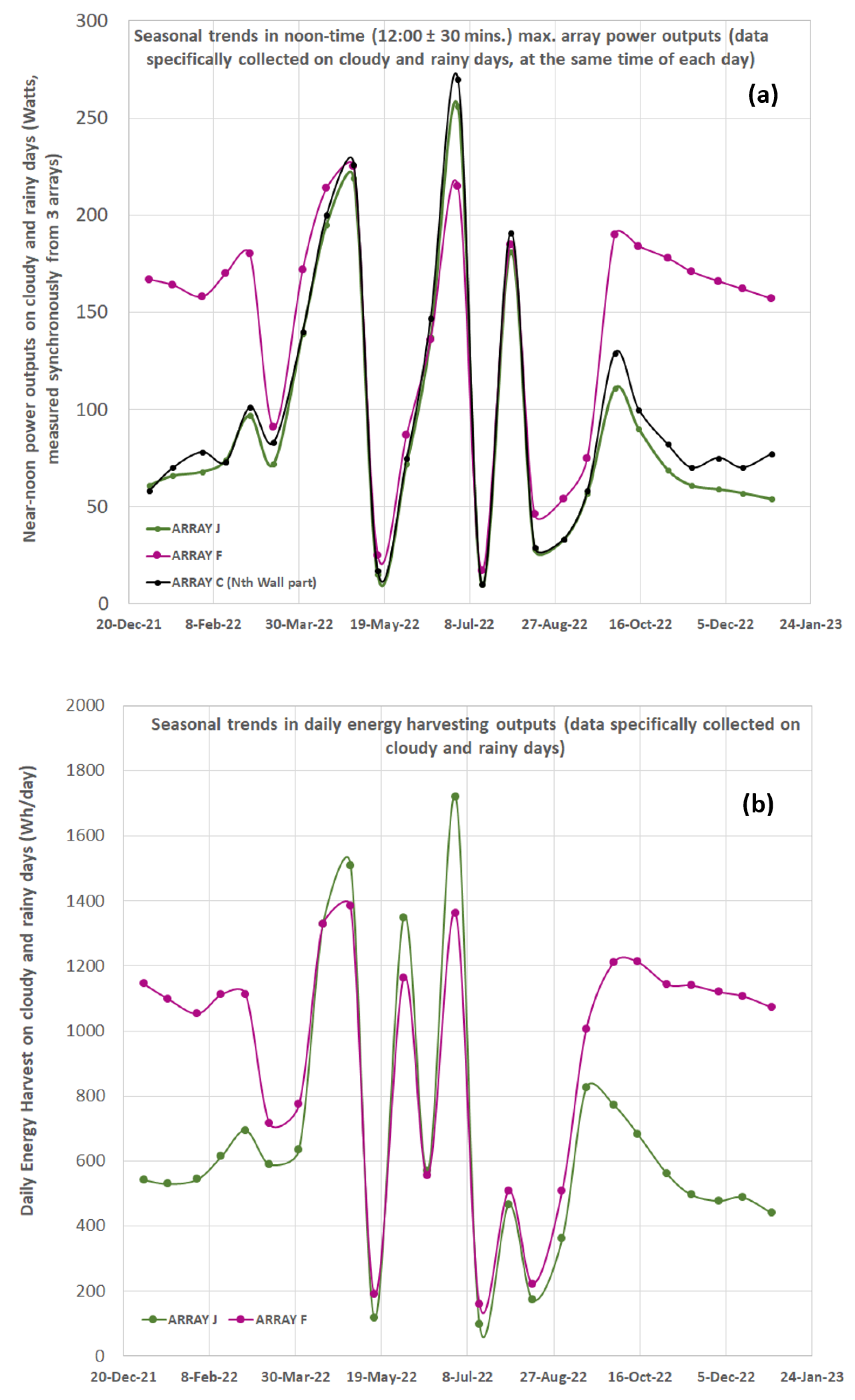The monitoring results of the energy harvesting behavior of the greenhouse installation at a system level, as well as the systematic performance differences noted between the differently designed or differently mounted window groups have provided useful insights in relation to the practical application potential of high-transparency solar windows. Multiple findings made were originally unexpected and related primarily to the measured details in the seasonal and weather-related energy harvesting window behaviors.
3.1. Long-Term and Seasonal Greenhouse-Total and Array-Specific Energy Output Trends
Continuous observations of the recorded power and energy data were made throughout 2021–2022, and the observed energy production trends were also analyzed in comparison with a reference conventional (roof-based, near-optimally tilted) 6.6 kW
p rooftop PV installation located in Perth metropolitan area. This reference roof-top PV installation is facing the north-western direction and is tilted at 22.5° to the horizontal plane; this combination of parameters provides the practically optimum year-round PV energy production in Perth, considering the local latitude and the applicable local industry-standard roof pitch angles.
Figure 4a shows the comparative energy generation trends observed during the autumn and winter seasons of 2021, shortly after the greenhouse construction. A long-term daily energy generation datalog recorded from an array of 12 windows mounted on the roof of grow-room #3 is also shown in part (b), revealing the absence of any significant performance degradation and relative stability of daily energy outputs throughout seasons. The installation-total long-term daily energy production data trend (
Figure 4c) shows that the season-dependent variations in the daily energy harvest were relatively small, considering the sunny days throughout months and years.
The initial measurement results analyzed over the autumn–winter of 2021 suggested that Murdoch University Solar Greenhouse demonstrated a relatively stable energy production output, despite having a large area of vertically oriented windows (e.g., on North and West Walls), and on some rainier days even outperformed a standard 6.6 kWp PV panels installation mounted on an optimally tilted roof area (considering the installed PV capacity difference; data shown in
Figure 4a). Both the North and West wall areas performed stably in terms of energy harvesting, particularly on some wall areas in the summer months of 2021–2022, considering the non-optimum orientation/tilt angles, as well as the weather conditions during the winter of 2021. The energy amounts harvested daily approached ~19 kWh/day. Some energy harvesting limitations were also observed, arising due to the maximum AC power output limitations of microinverters used, and affecting primarily the roof-mounted arrays on summer days.
In can be noted from the data of
Figure 4b presenting the long-term performance of a roof-mounted 12-window array, that throughout all seasons, the minimum rainy-day daily energy outputs were typically not below ~30% of a peak-day production for each corresponding week of the year. Compared with the summer-time daily energy production data also available from the same reference rooftop PV system, the seasonal variations in the daily energy outputs were smaller on the greenhouse roof. On sunny days, the greenhouse roof (Array G, roof of room #3) production from solar windows varied from approximately ~1.1 kWh/day in winter to ~2 kWh/day in summer. The season-dependent daily energy production variations of the reference 6.6 kW
p conventional monocrystalline silicon-based rooftop PV system was larger, from approximately ~17 kWh/day on peak days in winter to ~40 kWh/day on peak days in summer. The total energy production output of greenhouse exceeded 11 MWh in late May of 2023.
The data of
Figure 4 confirms that ClearVue solar windows are suitable for efficient solar energy harvesting in adverse environmental conditions (e.g., during rainy winter days), even when installed at a range of different azimuth and tilt angles, in an agricultural setting where dust contamination from nearby land areas is also a factor. This finding was expected, due to the window design features (multi-oriented PV modules and fluorescent interlayers) providing the capability of capturing the incoming sunlight energy from a wide range of incidence angles including in diffused irradiation conditions.
Significant energy savings were demonstrated in greenhouse grow-rooms fitted with ClearVue solar windows, which demonstrated approximately 40% of total (season-averaged) energy self-sufficiency, due to the renewable energy generated.
Figure 5 shows the measured electric energy consumption trends in all four grow-rooms, on a time scale of almost 1 year. Further optimizations to be applied to the internet-of-things (IoT) based HVAC control algorithms, involving more efficient air cooling applied through high-pressure evaporation of water mist, are expected to further improve the energy self-sufficiency, reducing the running time of high-power reverse-cycle air conditioners.
As was expected, conventionally glazed Room 1 used electricity at a significantly higher rate, compared to solar grow-rooms, due to its significantly larger (by almost 30%) solar heat gain coefficient. Marginal (few %) energy use differences were noted between grow-rooms fitted with solar windows, possibly also correlated with their slight solar heat gain differences. The electricity consumption figures were obtained from commercial energy metering equipment capable of 0.01 kWh display resolution, which ensured that the small differences in the energy use data observed between the solar-glazed rooms were still much greater than the error margins. The three monthly averaged energy self-sufficiency level (for all 3 CPV rooms) was equal to PV Generation Total/Total Energy Used = 1165 kWh/3082.42 kWh = 37.8%—averaged between 16 April to 21 July 2021, with the record rainy June and July months in 2021. On the other hand, during the same three-month period, the ratio of total energy generated in Rooms 2, 3, and 4 to the metered grid-imported energy was as high as 49.7%. The cost of importing from grid (only ~2.3 MWh in 3 months’ time) was approximately AUD 300/month, using off-peak Perth tariff of AUD 0.3896/kWh) indicates rather small running costs, compared to the expected running costs of energy in other R&D greenhouses at Murdoch Campus. No electric energy storage systems were used during this study, even though the energy performance of solar greenhouse would have been further improved if batteries were installed.
Figure 6 shows the remarkable stability of the monthly energy output from a 12-window array mounted vertically on the north-facing wall of greenhouse (Array F, with 7 windows on the wall of room #3 and 5 windows on the wall of room #4).
The superior stability of the monthly energy outputs was initially unexpected to be measured in any wall-mounted window array, considering the much stronger seasonal variations seen in roof-mounted PV (e.g.,
Figure 4a,b). The strong, season-dependent, and also weather-dependent performance and behavior differences between the nearby north-facing wall-mounted arrays of solar windows of slight design type differences were also not foreseen initially. As an example, windows of Array J (wall of Room 2) have consistently generated daily energy outputs very similar to Array F (mainly wall of Room 3) during sunny winter days; however, they also produced substantially weaker daily energy in either the very cloudy rainy autumn and winter conditions or during summer days. Windows of all PV arrays had identical glass and PV module dimensions and structure, and the same glazing system design including optical coatings. Windows of Array J had two strongly particle-loaded PVB interlayers of standard thickness 0.76 mm, while most of the Array F windows also used two particle-loaded fluorescent interlayers, one being of much smaller particle concentration. Windows of Room 4 design type (eg Arrays C and D) contained a single particle-loaded fluorescent interlayer of smaller concentration, and another standard (non-fluorescent) PVB interlayer.
These initially unexpected strong seasonal variations in the relative energy-output performance of Array J windows vs. Array F can be illustrated by plotting the intra-day energy production outputs of different window arrays, as well as intra-day array average power outputs. The data of
Figure 7 (collected using Enphase Enlighten online data interface) clearly illustrate the large energy harvesting efficiency differences between different window designs (and also between the three different wall arrays and one roof array) seen in summer (16 February 2023) and also the much smaller differences for the wall arrays in winter (3 July 2021). The observation results were repeatable with each passing season; particular data acquisition dates were chosen for illustration purposes only.
It is particularly interesting to note that Array J (wall of Room 2) windows in fact outperformed Array F windows consistently in terms of the power output during some winter days (illustrated in
Figure 7b), by several %, while following the identical power generation intraday time-dependency curve during practically all of the daylight hours. During rainy conditions between April and early June of 2023, Array J windows produced substantially smaller daily energy outputs compared to Array F (
Figure 7c); the main observed trends were identical also back in 2021–2022.
3.2. Long-Term Performance Monitoring of Solar Photovoltaic Windows of Several Different Design Types
During the initial (pre-installation) field testing of all windows conducted at Murdoch Campus in February 2021 in outdoor natural-sunlight conditions, the performance differences between three different window design types were noted, even though testing at standard test conditions (STC) could not be then performed, and the prior factory tests revealed only marginal (few %) peak power-output performance differences when measured at normal incidence angle. The measured optical transmission spectra and haze characteristics of thin low-iron glass samples laminated with either the “PVB-1”, or “PVB-2” (
Figure 8) confirm that “PVB-2” interlayers induce significantly more light scattering over a very broad spectral band (evident from the measurements of direct transmission, total transmission, and haze), and are also capable of absorbing a greater fraction of short-wavelength sunlight, compared to “PVB-1” interlayers. These findings were expected and correlated with the known (though not disclosed, for reasons of confidentiality) differences in photoluminescent material particle concentrations in different extruded PVB materials.
The following interlayer design differences related to the glazing design differences between grow-rooms 2, 3, and 4:
Room 2 windows used two slightly higher-haze, but identical interlayers (“PVB-2” + “PVB-2”);
Room 3 windows used two differently doped interlayers (“PVB-2” + “PVB-1”);
Room 4 windows used a single fluorescent interlayer (high-clarity “PVB-1”), with the other interlayer being “Ordinary PVB”.
Two PVB interlayers were needed to laminate the inner pane (integrated LSC-type panel) of each triple-glazed window system; each inner pane was itself composed of three 4 mm-thick low-iron glass plates.
When measured at the optimized (by way of measuring the short-circuit current Isc) angles of incidence, and at peak outdoor sunlight irradiation during summer, the windows (expectedly) showed the same open-circuit voltages near 61 V; however, the measured Isc values differed systematically from ~840–860 mA in windows of Room 4 design, to ~950–980 mA in windows of Rooms 2 and 3. Therefore, the solar energy harvesting performance was initially expected to differ systematically by up to ~10% between the extremely-low-haze Room 4 and other ClearVue rooms 2 and 3, which used denser concentrations of functional materials in lamination interlayers.
Initial monthly PV production output comparisons made between the different rooms of the greenhouse during the winter of 2021 have revealed that an average (including all wall- and roof-mounted windows) north-oriented window in Room 3 generated up to ~4.46% more energy in July 2021, compared with Room4. During the same observation period, Room 3 windows have also produced approximately 1.46% more energy, compared with Room 2.
Due to the interlayer design differences being rather small (a small fraction of 1 wt% in the active materials concentration differences between different PVB types), a more conclusive evaluation of design-dependent window performance differences must be performed, based on the results of longer-term studies including the detailed analysis of seasonally dependent data trends. It was expected that energy harvesting performance differences between different interlayer types will be magnified during summer months, at higher sunlight intensities and at larger noon-time incidence angles of solar radiation onto wall windows. It can also be expected that the performance differences (however small) will be seen clearer from longer-term cumulative energy output observations.
Summer (December 2021) north-wall windows energy generation trends by windows of different designs were also studied. Active materials inside interlayers are expected to receive much stronger fluorescence excitation intensities during the summer months and therefore should respond stronger in terms of redistributing a fraction of incident light energy inside glazing structures. The roof-mounted windows did not show any substantial (exceeding several %) monthly energy harvesting differences between the three rooms during the summer season, as opposed to the wall windows, which may be related to the effects of stronger glass contamination, compared to wall-mounted windows. This contamination was expected to occur, due to the greenhouse location being close to other agricultural facilities operating in the open field and producing some dust emissions; Perth climate also features strong winds frequently. During the autumn and winter months, the roof windows of Room 3 have outperformed the roof windows of rooms 2 and 4; it is possible that the rains provided some surface cleaning effects, removing the dust contamination from the glass. Additionally, the window energy performance differences were expected to be maximized during the conditions where maximum-intensity near-noon sunlight is incident onto glass at a large oblique angle, and these conditions occurred more frequently on wall areas during summer months. The wall-based summer-time per-window energy output trends were different from what was originally expected (e.g., a denser double-interlayer of Array J in Room 2 has previously produced the largest recorded (of all wall arrays) winter-time per-window energy harvest of up to ~153 Wh/window/day in June of 2021, but the same array (J) was also generating around 50% of the daily energy output, compared to Array F during December 2021. Longer-term observations of the per-window energy yield differences between the different wall-mounted arrays made between April 2021 and October 2022 have revealed that the windows of Array J (Room 2) generated ~5.6% less total energy than the wall windows of Room 4. At the same time, the minimum long-term energy-harvesting outperformance of Room 3 wall windows, compared with Room 4 (wall windows of Array C), was ~12%. This figure also correlates well with the original field performance evaluation tests made prior to the installation of solar windows into the greenhouse structure.
The long-term differences between the best-performing roof-mounted solar window arrays measured as lifetime energy generation figures reported between April 2021 and 8 March 2023 were as follows (
Table 2):
Even though the long-term data-logged outperformance of Array G over Array E was only ~2.92%, it is still a noticeable figure, considering the correlated higher performance of Room 3 wall windows, and other factors that were reducing the design-dependent performance differences for roof arrays particularly the contamination and higher glass and solar-cell temperatures affecting the peak-time performance of roof windows.
The data observations made it clear that different solar window designs have shown rather different energy harvesting behaviors, and that a multi-season extended study of energy harvesting outputs was still required to uncover the details of energy production differences. We developed custom methodologies for the investigation of window performance differences observed in correlation with varying solar geometry angles, seasonal sunlight intensity variations, and varying weather conditions.
In order to systematically evaluate the design-dependent solar window performance differences, it is necessary to devise a way of comparing both the short-term (daily) and the long-term (seasonal) energy harvesting performances, which would minimize the effects of random variables on measurements such as glass surface contamination, intermittent shading, or window assembly quality variations. In lab conditions, an extended PV metrology study would be required to address all issues, documenting the exact (array-averaged) power generation outputs of all window types at all possible simulated solar radiation incidence conditions (at 25C, STC, AM1.5G standard solar spectrum), involving both the horizontal and vertical incidence angle variations across their full range. But the measured performance differences of different window types are more of interest to be measured in the “real-world” conditions, which also include the atmospheric path, air temperature, sunlight intensity, and weather conditions variations. It is possible to study the energy harvesting behaviors of different window types installed in greenhouses by way of correlating the year-long recorded maximum daily window-array power outputs (obtained at near noontime on each day), with the total solar radiation flux incident onto window-array surfaces, which is dependent on near-noon solar geometry and calendar date. Plotting the yearly peak-normalized maximum array daily power outputs versus the peak-normalized solar radiation flux interception factor by the installation plane of solar windows will reveal whether the maximum solar radiation energy intercepted by any window is the only factor governing the maximum electric output of PV windows at any possible combination of the angles of incidence and weather conditions, or if there exist any other, window design-related factors, which also affect the window efficiency in any particular conditions.
The date/time-dependent solar geometry (astronomy) data for the local noon-time Sun Altitude and Sun Azimuth angles are available from [
31]; the data for the solar-angle and installation-angle-dependent solar radiation intensity falling onto arbitrarily oriented tilted window surfaces are readily available by using the relevant formula (Equation (1)) published in [
32].
where
α is the sun elevation angle,
β is the module tilt angle,
Θ is the sun azimuth angle, and
Ψ is the azimuth angle that the module faces.
Smodule and
Sincident are the direct-component light intensities on the module and of the incoming light in W/m
2, respectively. The simplest case for the Southern hemisphere is the vertical wall of PV modules directly facing the North direction (azimuth angle 0 degrees, tilt 90 degrees). In order to remove the peak-power variations induced by intermittent clouds and/or rainy-day effects (weather outliers), it is possible to plot the maximum recorded array output power observed within 1 h from noon (12 pm), during a time period within ±3 days from any selected day on a fixed dates-grid (arranged as follows: 1 January, 15 January, 1 January, 15 January, ….). Due to noon-time solar geometry angles changing slowly with the calendar dates, this method effectively reveals the yearly power generation trends for plotting against the solar flux interception factor.
Figure 9 shows the highly correlated datasets obtained using the power generation data from Array J. The data are plotted for both 2021 and 2022, and the array power data correlations with the incident solar radiation flux component variations remained apparent throughout years.
The close correlation between the two datasets plotted in
Figure 9 during most of the seasons is remarkable, and the departures from the close correlation of data during the summer months are also notable. Higher air temperatures and solar-cell surface temperatures expected during summer months would have normally reduced the max. daily power output of any conventional PV modules. Strong increases in the UV index in summer also would not fully account for the daily-maximum power improvements in conventional PV due to the low responsivity of silicon cells at short wavelengths.
Figure 10 shows the same normalized solar flux-correlated daily peak power dependencies for all three north-facing wall-based arrays (J, C, and F); polynomial fitted trendlines are also added. PV array-specific data curves are color-coded using the same notation as array coloring codes in the diagram of
Figure 3. The (minimum estimated) power output of the six wall-mounted windows of Array C were obtained by subtracting one half of the maximum nearby (Room 4) roof array output from the full measured Array C output. The resulting figures for Array C were then multiplied by two to compare the normalized data with the nearby 12-window wall-mounted arrays J and F.
It is notable that the peak-power trendlines of both other wall arrays (C and F) stay well above the solar flux interception curve throughout most of the warmer months, indicating weaker angular dependency of the power conversion efficiency, compared to Array J. The symmetry of all three window array datasets is still of the same character, with the normalized power generation peaking in winter (clearly correlated with the reducing Sun altitude angles near the winter solstice date) but dropping the power output at different rates with increasing Sun altitude angle in summer months. Even though more research may be required in this area, it is possible to evaluate the comparative trends in the energy harvesting behaviors of solar windows using this method. It is also possible to develop quantitative criteria for benchmarking the solar window performance characteristics versus the window design type using measured properties, e.g., the full width at half maximum (FWHM, measured in days) of the normalized maximum daily power generation curve of vertically mounted north-facing windows characterized over one year.
Figure 11a shows the monthly averaged yearly variations in the measured direct-beam solar radiation intensity for Perth; these data can also be included into the data normalizations used in previous datasets, to inspect whether the seasonal direct-beam solar intensity variations represent an additional major factor governing the solar window response functions plotted in
Figure 9 and
Figure 10.
Figure 11b shows the corresponding normalized datasets of arrays J and F long-term daily peak near-noon power variations, together with the re-normalized seasonal variations in the (monthly maximum) solar direct-beam intensity.
Figure 11 shows essentially the same data dependencies as those presented in
Figure 10, but with the solar radiation interception factor modified, accounting for the seasonal direct-beam intensity variations. Closer data correlations seen in
Figure 9 and
Figure 10 suggest that the Sun altitude angle is likely still the main governing factor, rather than the monthly maximum direct-beam intensity on its own. The window performance-related features in the data remain the same, showing that solar windows of different design types respond differently to sunlight incidence-angle changes. It is more evident from
Figure 11 that the peaks of normalized array power distributions do not exactly coincide, suggesting different angle-dependent responses in different solar window designs.
Figure 12 shows the plots of normalized max. daily power output trends for two roof-based window arrays versus the solar geometry function governing the direct-beam intercepted solar radiation flux falling onto roof windows.
It is again notable from the data dependencies that the roof-mounted solar windows also show some outperformance (compared to the solar radiation flux scaling function) during most of the warmer months, particularly during the less-rainy period from August to February. The minima and maxima of the normalized power generation curves are shifted with respect to the corresponding extrema of the normalized direct-beam solar flux interception curve, again suggesting the maximized power output of roof windows being generated at orientations away from the normal incidence. Conventional roof-mounted PV modules would be expected to follow the solar radiation flux interception function much more closely over the seasons.
Another notable feature of unconventional photovoltaics based on LSC-type devices is their widely reported improved stability of energy outputs with respect to rainy-weather conditions, compared to ordinary PV.
Figure 13 presents daily measured (near-noon) array power data points (collected at the same time from all arrays, on the same specifically selected cloudy days throughout 2022), and the corresponding daily energy harvesting amounts. Similarly, to the methodology used to collect solar geometry-related power output data, the data acquisition dates were selected within ±3 days from any selected day on the same fixed-dates calendar grid. Synchronous data collection timing (corresponding to the observed near-noon intraday local maxima of each array power) has ensured meaningful comparisons of the rainy-day array performance. It can be noted that Array F strongly outperformed Array J on the days of most adverse winter weather, but not during the relatively sunny cloudy winter days. These differences may be related to the variations in the solar spectrum-dependent and/or diffuse radiation collection behaviors between differently designed solar windows, which feature a different balance between the effects of luminescence and scattering on the energy collection. The substantially advantageous performance of Array F over other wall-mounted window arrays during the cloudier days throughout warm seasons is also evident from the data.
Again, strong seasonal and window design-dependent performance differences were seen, but these were no longer governed by the solar geometry variations, which was expected. The daily recorded energy outputs (
Figure 13b) correlated with near-noon array power trends, and also showed large performance differences during summer months. The performance differences between different window designs were seen quite clearly during most of the year.
Energy harvesting behavior differences of the roof-mounted window arrays in rooms 2, 3, and 4 were much less notable, compared with wall arrays. These differences were also season- and weather-dependent. Running the daily energy-output statistics revealed better cloudy- and rainy-day stability of Room 3 roof windows.
Figure 14 shows the long-term statistical distributions of the roof arrays’ energy output, plotted as the counted percentage of days between April 2021 and March 2022, during which the daily energy outputs have exceeded a given fraction of the maximum-observed daily energy harvest.
The roof of Room 3 generated higher daily energy outputs much more frequently, compared with other roof-mounted windows, almost regardless of weather changes. The daily energy harvests of Array G stayed in the top 10–25% of the maximum observed significantly more frequently than the energy outputs of nearby arrays on roofs of Rooms 2 and 4.
